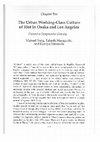Papers by Takeshi Haraguchi
Shipbuilding and Ship Repair Workers around the World
Japanese Journal of Human Geography
Japanese Journal of Human Geography, 2003

After the Great East Japan Earthquake of March 11, 2013, the question of the “infrastructure cris... more After the Great East Japan Earthquake of March 11, 2013, the question of the “infrastructure crisis” became widely discussed. Certainly, the earthquake destroyed the infrastructure of the affected areas. However, unlike the Great Hanshin Awaji Earthquake of 1995, it also brought an even greater crisis. The earthquake and tsunami caused a meltdown at Fukushima No.1 nuclear power plant, leading to widespread exposure to radioactivity. This danger continues to the present day. The leakage and spread of radioactivity cannot be contained: it penetrates the infrastructure and is already becoming part of everyday life. At the same time, many laborers are hired under very obscure employment terms to “decontaminate” the site. There is no way to measure the amount of damage they sustain to their health. However, even these “decontamination” operations conducted at the cost of such great sacrifice do little except to mask the infrastructure crisis. Despite everything, the reckless misuse of th...

Marxism and Urban Culture , Apr 24, 2014
In chapter 10, "The Urban Working-Class Culture of Riot in Osaka and L.A: Toward a Comparative Hi... more In chapter 10, "The Urban Working-Class Culture of Riot in Osaka and L.A: Toward a Comparative History," a team of scholars comprised of Manuel Yang, Takeshi Haraguchi, and Kazuya Sakurada analyze various fandamental aspects of synchronous urban riots in Osaka and Los Angeles. These riots erupted in working-class districts that were products of industrial capitalist development in the half-century arc from its late nineteenth-century laissez-faire from to its post-World War II Keynesian permutation. A major source of this transformation was struggles of the industrial working class, whose self-definition spanned a wide gamut, from rickshaw drivers and professional gamblers to vagrants and waterfront workers, as shown by the 1903 Osaka riot, 1905 formation of the Industrial Workers of the World, and the trans-Pacific radical culture that they had forged. While these struggles - especially those of the waterfront workers, who later organized a "trans-Pacific strike" in the wake of the first Kamagasaki Riot - led capital to restructure itself to offer workers a social compact, it also restricted their class identity hierarchically according to the hegemony of the urban industrial factory, which marginalized day laborers, blacks, and lumpen-proletarians. When these latter members of the working class revolted, with their demand for civil rights and rioting during the 1960s, they attacked the city that had become a socialized factory and created a new militant lumpen-proletarian culture that connected Black Power on the West Coast with the romusha of Osaka. This signaled a histrical return, albeit in a post-industrial context, to what E. P. Thompson called "class struggle without class," as social antagonisms no longer manageable by the Keynesian dictates of industrial labor spread among auto workers, prison inmates, and indigenous peoples, to which the ruling class responded with state terror, deindustrialization, financialization, and other neoliberal counteroffensives. The L.A. and Osaka Riots of the early 1990s demonstrated the further dissolution of a singular class identity and the generalized condition of class struggle, which have made it impossible for us to conceive either "city" or "culture" in a reified, fetishistic manner that mirrors the residual ideology of the ascendant era of urban industrial capitalism.









Uploads
Papers by Takeshi Haraguchi